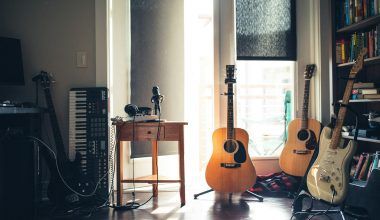Creating a home sound studio is an exciting project that allows you to bring professional-quality audio into your personal space. Whether you’re a musician, podcaster, or audiophile, having a dedicated studio at home can make a world of difference. But how do you go about designing a home sound studio that meets your needs without breaking the bank? Let’s walk through the essentials.
Understanding Your Goals
Before diving into the nitty-gritty details, it’s crucial to define your purpose. Are you looking to record music, produce podcasts, or simply enjoy high-quality sound? Knowing your goals helps you plan the space, choose the right equipment, and optimize your budget.
For instance, a musician’s home studio might need more instruments and recording gear, while a podcaster’s studio could focus on microphones and soundproofing. Clarity about your goals ensures that your design decisions align with your intended use.
Choosing the Perfect Space
The first step in home sound studio design is finding the right spot in your home. Ideally, you want a room that’s isolated from external noise and distractions. Basements, attics, or spare bedrooms often work well.
Consider the room’s size and shape, too. A rectangular room is typically better for acoustics than a square one. Avoid rooms with too many windows, as glass surfaces can cause sound reflections. If your chosen space isn’t perfect, don’t worry. You can make adjustments with proper acoustic treatment.
Acoustic Treatment Basics
Sound quality is the heart of any home sound studio, and acoustic treatment plays a pivotal role. Without it, even the best equipment can fall short. Acoustic treatment involves managing how sound behaves in your room. Here are the basics:
- Absorption: Use foam panels or fiberglass to absorb sound waves and reduce echoes.
- Diffusion: Scatter sound waves with diffusers to prevent harsh reflections.
- Bass Traps: Place these in corners to control low-frequency sounds.
These elements work together to create a balanced and clear audio environment. Don’t forget to address the ceiling and floor, as sound can bounce off these surfaces too.
Soundproofing Your Studio
Soundproofing is different from acoustic treatment. While the latter improves sound quality inside your studio, soundproofing keeps unwanted noise out and prevents your music or recordings from disturbing others.
To soundproof your home sound studio, you can:
- Add mass to walls using dense materials like drywall or mass-loaded vinyl.
- Seal gaps around doors and windows with weatherstripping.
- Install a solid-core door for better sound isolation.
- Use thick rugs or carpets to dampen floor vibrations.
Soundproofing might require more effort and investment, but it’s worth it for a truly immersive audio experience.
Essential Equipment for Your Home Sound Studio
No home sound studio design is complete without the right equipment. Your choices will depend on your purpose, but here are some must-haves:
- Microphones: Invest in a high-quality microphone suited to your needs. Condenser mics are great for vocals, while dynamic mics excel in live settings.
- Audio Interface: This device connects your microphone and instruments to your computer. Look for one with multiple input options.
- Headphones and Monitors: Get studio-quality headphones and speakers to hear your recordings accurately.
- Computer and DAW: Choose a reliable computer and digital audio workstation (DAW) software for recording and editing.
- Cables and Stands: Don’t overlook essentials like XLR cables and adjustable mic stands.
With this equipment, you’ll have a solid foundation for creating high-quality audio projects.
Organizing Your Studio Layout
How you arrange your equipment and furniture can impact both functionality and acoustics. Start by positioning your desk and monitors against the shorter wall of the room, facing out. This setup minimizes reflections and provides a more accurate sound.
Keep your workspace clutter-free and ensure that cables are neatly organized. Use cable management solutions like clips or sleeves to avoid a tangled mess. A well-organized studio not only looks professional but also makes your workflow smoother.
Lighting and Ambiance
While sound is the priority, don’t underestimate the importance of lighting. A well-lit space can boost creativity and reduce eye strain during long sessions. Use adjustable LED lights to create a comfortable atmosphere. Consider adding some color-changing lights for a touch of personality.
Natural light is great, but make sure you can control it with curtains or blinds to avoid glare on screens or reflections off surfaces.
Personalizing Your Space
Your home sound studio should reflect your style and inspire creativity. Add personal touches like posters, plants, or a comfy chair. These elements make the space more inviting and enjoyable to work in.
Budget-Friendly Tips
Designing a home sound studio doesn’t have to be expensive. Here are some tips to save money:
- DIY acoustic panels using affordable materials.
- Look for second-hand equipment in good condition.
- Start small and upgrade as your needs grow.
- Use free or budget-friendly DAW software.
With some creativity and smart shopping, you can build a professional-quality studio without overspending.
Maintaining Your Studio
Once your home sound studio is set up, regular maintenance ensures it stays in top condition. Keep your equipment clean and dust-free. Check cables and connections periodically to avoid unexpected issues. Organize files on your computer to keep your workflow efficient.
Final Thoughts
home sound studio design is a rewarding endeavor that combines functionality, creativity, and passion. By understanding your goals, optimizing your space, and investing in the right equipment, you can create a studio that meets your needs and fuels your projects.
Remember, it’s okay to start small. The most important thing is to take that first step and enjoy the process of building your dream studio. Happy designing!
For further reading, explore these related articles:
- Justin Bieber’s Popular Songs: A Journey of Musical Hits
- Indian Songs on Billboard – A Proud Moment for Indian Music
For additional resources on music marketing and distribution, visit Deliver My Tune.






